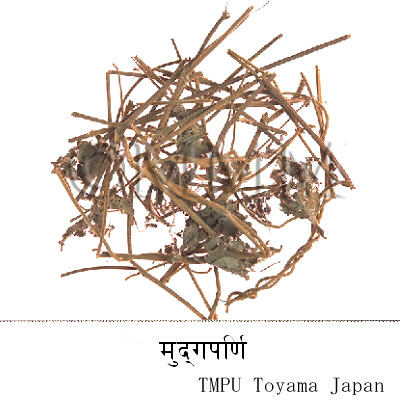Crude drug sample data base
※Click on the image to enlarge it.
Crude drug name | Market name | Mudgaparni |
|---|---|---|
| Formal name | Mudgaparni | |
Other names Tips! | Mugani (B), Mugani, Mugawana (H), Pillippersara (Te), Naripayar, Panipayar (Ta) | |
| Original plant name | Phaseolus trilobus Ait. | |
| Family name | Leguminosae | |
| Used part | Classification | Plant origin | Sub classification | stem + leaf |
| Collection information | Kingdom of Nepal, Kathmandu | |
| Collection date | 1983/07/31 | |
| Collector | Tsuneo Namba, et al. | |
| TMPW No. | 5818 | |
The capital city, provincial capital city or the representative
location of its administrative area is indicated.
location of its administrative area is indicated.
Production area information
https://ethmed.toyama-wakan.net/img/pin_san.png
27.7172453
85.3239605
Collection information
Kingdom of Nepal,Kathmandu
https://ethmed.toyama-wakan.net/img/pin_nyu.png
Scientific information data base
| Crude drug name | Ayurvedic name or Sanskrit name, English name | Mudgaparni | |||
|---|---|---|---|---|---|
| Synonyms | Kakaparni, Surpaparni, Alpika, Saha, Kakamudga, Marjaragandhika, Simbi, Dasi, Ksudrasaha, Vanamudga, Kinkinika, Supyaparni. | ||||
| crude drug image |
| ||||
| Original plant name | Phaseolus trilobus Ait. | ||||
| Family name | Leguminosae | ||||
| Used part | Whole plant, Root. | ||||
| Distribution area | On the Himalaya upto 7000 feet. | ||||
| Remarks | Common. | ||||
| Common uses | Fruit is cooling, dry bitter with a flavour, aphrodisiac, astringent, styptic and anthelmintic. It is used eye diseases, consumption, inflammation, fever, scorpion sting, burning sensation, thirst, piles, dysentery, cough, gout and biliousness. Leaves are tonic, cooling, antibilious, febrifuge and sedative. They are used in cataplasms for weak eyes; administered in decoction in irregular fever. | ||||
| Therapeutic uses | Agnimandya (indigestion), Atisara (diarrhoea/diarrhea), Sopha (oedema), Jvara (fever), Daha (burning sensation), Grahani (sprue syndrome), Arsas (haemorrhoids/hemorrhoids), Krmi (worm infestations). | ||||
| Chemical constituent | unknown Not mentioned. | ||||
| Medical system | Ayurveda (Traditional Indian medicine) | ||||
| Traditional concept | Rasa (Taste) | Madhura (Sweet) | |||
| Virya (Potency) | Sita (Cold) | ||||
| Guna (Quality) | Laghu (Light), Ruksa (Dry) | ||||
| Vipaka (Post digestive taste) | Madhura (Sweet) | ||||
| Karma (General action) | Sukrala (increases semen), Caksusya (good for eyes), Grahini (constipative), Krmighni (anthelmintic), Anulomana (helps in downward passage of vayu), Dahaprasamana (reduces burning sensation). | ||||
| Dosakarma (Action on dosa) | Decreases Vata Pitta | ||||
| Traditional usage | 1. Paste of Putika (Holoptelia integrifolia), Devadaru (Cedrus deodara), Mamsi (Nardostachys jatamansi), Indravaruni (Citrullus colocynthis), Guduci (Tinospora cordifolia), Mudgaparni (Phaseolus trilobus) and Kakanasa (Martynia annua) destroys "Mandala kustha" (a kind of skin disorder). 2. Mudgaparni is one of the ingredients in "Mrtasanjivana agada", a compound preparation used to remove "Visa" (poisoning). 3. Mudgaparni comes into the formulations "Dvipancamuladya" or "Jivaniya ghrta" and "Jivakadya sneha" (three formulations) which are recommended in "Vatarakta" (blood vitiated by Vata). 4. In "Musika visa" (rat poisoning) the powder of its root is given internally. 5. Mudgaparni is used in "Pittajajvara" (fever due to the predominance of Pitta). It reduces burning sensation. 6. In treatment of thirst caused by alcoholic drink, ice cold water processed with Patala (Stereospermum suaveolens), Utpala (Nymphaea stellata) root and Mudgaparni and mixed with Pippali (Piper longum) should be given. 7. With the paste of Jaggery, Jivaka (Malaxis acuminata), Mudgaparni, Masaparni (Teramnus labialis) and Duralabha (Tragia involucrata), ghee should be cooked along with eight times milk. Taken in drink, food and linctus, it alleviates cough caused by Pitta. 8. Mudgaparni is one of the ingredients of "Brahmarasayana" and "Cyavanaprasa" (two formulations) which are popular "Rasayana" (rejuvenative) formulations. 9. Mudgaparni is one of the ingredients in "Sastikaguda" (a formulation), a compound preparation used as aphrodisiac. | ||||
| Related drugs | Vigna adenantha (= Phaseolus adenanthus G.F. Meyer) | ||||
| Comments | There is confusion in the botanical identification of Mudgaparni. Various commentators have given Vigna pilosa Baker, Phaseolus adenanthus G.F.W.Mey., and P. trilobus auct. non L. as Latin names for Mudgaparni. In North India P. trilobus is used for Mudgaparni whereas in South India, Vigna pilosa or Phaseolus adenanthus G.F.W.Mey. are used though P. trilobus is available. From Shivadatta's commentary in Shivadattanighantu, quoted in Bhavaprakasa nighantu, it is said that mudgaparni should have yellow flowers (pitapuspaka). Hence it is inferred that P. trilobus having yellow flowers should be regarded as Mudgaparni. Mudgaparni is included in Jivaniya, Sukrajanana and Madhuraskandha gana by Caraka. Susruta includes it in Kakolyadi, Vidarigandhadi gana. Its synonym supyaparni indicates that its is used to make soups. Marjaragandhika denotes that it has the smell of cat. | ||||
| References | Reference book Tips! | [2] Indian Medicinal Plants - A Compendium of 500 species, Varier, P.S., Orient Longman Ltd. Chennai (Madras) Vol. 5 (Repr.1997), pp 370-373 Glossary of Indian Medicinal Plants, 1956. Chopra, R.N., Nayar, S.L. and Chopra, I.C., Council of Scientific & Industrial Research, New Delhi. - New Edition (1996) National Institute Science Communication; Supplement p 190 Ayurvedic Drugs and Their Plant Sources, 1994. Sivarajan, V.V. and Balachandran, I., Oxford & IBH Publishing Co. Pvt. Ltd., New Delhi pp 304-305 Indian Medicinal Plants (Second Edition), Vols. 1-5, 1993. Kirtikar, K.R. and Basu. B.D., Periodical Experts Book Agency, Delhi Vol. 1, pp 794-795 Indian Materia Medica, Vols. 1-2, 1976 (Repr. 1989). Nadkarni, A.K., Popular Prakashan Pvt. Ltd., Bombay p 942 Dravyagunavijnana, Vols. 1-5, reprint 1998. Sharma, P.V., Chowkhambha Bharati Academy, Varanasi Vol. 2, pp 745-747 Classical uses of Medicinal Plants, 1996. Sharma, P.V., Chaukhambha Visvabharati, Varanasi p 306 | |||
| Last renewal date | 2023/12/12 | ||||



